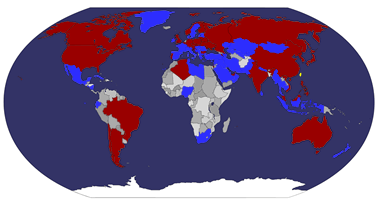Mémorial de la guerre du Haut-Karabagh


The Nagorno-Karabakh War was an armed conflict that took place from February 1988 to May 1994, in the small enclave of Nagorno-Karabakh in southwestern Azerbaijan, between the majority ethnic Armenians of Nagorno-Karabakh backed by the Republic of Armenia, and the Republic of Azerbaijan. As the war progressed, Armenia and Azerbaijan, both former Soviet Republics, entangled themselves in a protracted, undeclared war in the mountainous heights of Karabakh as Azerbaijan attempted to curb the secessionist movement in Nagorno-Karabakh. The enclave's parliament had voted in favor of uniting itself with Armenia and a referendum was held, and the vast majority of the Karabakh population voted in favor of independence. The demand to unify with Armenia, which proliferated in the late 1980s, began in a relatively peaceful manner; however, in the following months, as the Soviet Union's disintegration neared, it gradually grew into an increasingly violent conflict between ethnic Armenians and ethnic Azerbaijanis, resulting in claims of ethnic cleansing by all sides.
Inter-ethnic fighting between the two broke out shortly after the parliament of Nagorno-Karabakh, an autonomous oblast in Azerbaijan, voted to unify the region with Armenia on February 20, 1988. The declaration of secession from Azerbaijan was the final result of a territorial conflict regarding the land. The circumstances of the dissolution of the Soviet Union facilitated an Armenian separatist movement in Azerbaijan. As Azerbaijan declared its independence from the Soviet Union and removed the powers held by the enclave's government, the Armenian majority voted to secede from Azerbaijan and in the process proclaimed the enclave the Republic of Nagorno-Karabakh.
Full-scale fighting erupted in the late winter of 1992. International mediation by several groups including Europe's OSCE failed to bring an end resolution that both sides could work with. In the spring of 1993, Armenian forces captured regions outside the enclave itself, threatening the involvement of other countries in the region. By the end of the war in 1994, the Armenians were in full control of most of the enclave and also held and currently control approximately 9% of Azerbaijan's territory outside the enclave. As many as 230,000 Armenians from Azerbaijan and 800,000 Azeris from Armenia and Karabakh have been displaced as a result of the conflict. A Russian-brokered ceasefire was signed in May 1994 and peace talks, mediated by the OSCE Minsk Group, have been held ever since by Armenia and Azerbaijan.
La guerre du Haut-Karabagh désigne le conflit armé qui a eu lieu entre février 1988 et mai 1994 dans l'enclave ethnique du Haut-Karabagh, en Azerbaïdjan du sud-ouest, entre les Arméniens de l'enclave, alliés à la république d'Arménie, et la république d'Azerbaïdjan. Le 26 février 1988 défilent à Erevan un million de personnes, revendiquant le rattachement du Haut-Karabagh à l'Arménie. Le parlement de l'enclave, qui vote l'union avec l'Arménie le 20 février 1988, et un référendum accordé à la population déterminent un même souhait. La demande d'union avec l'Arménie, qui s'est développée vers la fin des années 1980, a débuté pacifiquement mais, ensuite, avec la désintégration de l'Union soviétique, le mouvement devient un conflit violent entre les deux groupes ethniques, aboutissant ainsi à des allégations de nettoyage ethnique par les deux camps.
Cette guerre est un des conflits ethniques les plus destructeurs ayant surgi après la décomposition de l'Union soviétique, en termes de nombre de morts et pertes de propriété. La déclaration de sécession de l'Azerbaïdjan est le résultat final d'un « ressentiment éprouvé par les membres de la communauté arménienne du Haut-Karabagh envers les limitations imposées par les autorités soviétiques et azerbaïdjanaises concernant la liberté culturelle et religieuse », mais, plus important, d'un conflit territorial.
Tout comme le mouvement sécessionniste parcourant les républiques baltes d'Estonie, de Lettonie et de Lituanie, le mouvement a favorisé et symbolisé l'implosion de l'Union soviétique. Lorsque l'Azerbaïdjan a déclaré son indépendance et a supprimé les pouvoirs exercés par le gouvernement de l'enclave, la majorité arménienne a voté sa séparation de l'Azerbaïdjan. Avec la progression des évènements, elle a proclamé la république du Haut-Karabagh.
Des combats de grande ampleur ont lieu vers la fin de l'hiver 1992. La médiation internationale de plusieurs groupes comme l'OSCE ne peut pas trouver une résolution du conflit qui satisfasse les intérêts des deux cotés. Au printemps 1993, les forces arméniennes s'approprient des régions à l'extérieur de l'enclave, soulevant des menaces d'intervention d'autres pays de la région. En 1994, vers la fin de la guerre, les Arméniens contrôlent non seulement l'enclave montagneuse, mais aussi 9 % du territoire azerbaïdjanais (14 % avec l'enclave). Le conflit a fait 400 000 réfugiés arméniens d'Azerbaïdjan et 800 000 réfugiés azéris d'Arménie et du Karabagh. Un cessez-le-feu est signé en mai 1994 avec la médiation russe. Des négociations entre les deux pays impliqués, sous la supervision du Groupe de Minsk de l'OSCE, ont eu lieu depuis lors.









.jpg)























 taiwan
taiwan  cover or postcard
cover or postcard  FDC
FDC 






























































































No comments:
Post a Comment